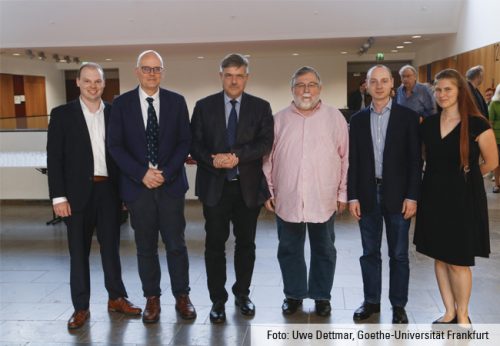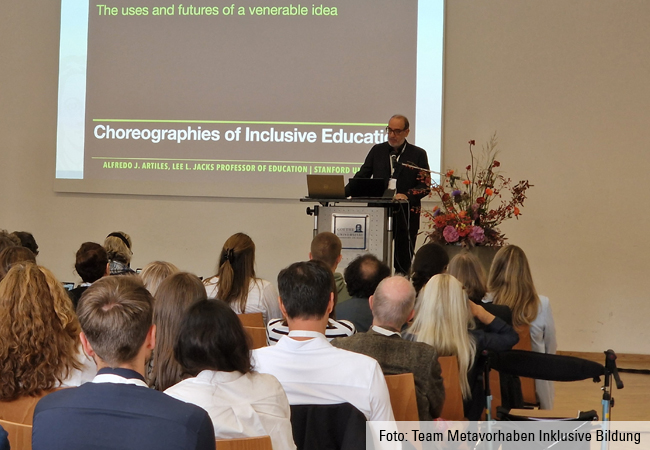A meeting of Hellenic scholars recalled the influential edition of the Strasbourg Papyrus 25 years ago, which had its origins in Frankfurt. Its editors are already preparing a new publication on Empedocles.

Anyone entering the IG Farben Building gets a good view of Empedocles (see picture right). But who was this philosopher, and why should he still be important to us today? “First of all, he has a place in the history of natural science, because he established the theory of the four elements fire, water, earth and air. Even though these are not the elements in the modern periodic table, the concept of ‘elements’ has certainly had a decisive influence on modern science,” explains Professor Hans Bernsdorff from the Institute of Classical Philology, who has just delivered a lecture on Empedocles at the Night of Science on the Riedberg science campus. Empedocles, he says, developed more basic principles for explaining the physical world, and also described various objects in terms of quantities, similar to the chemical formulas we still use today. Second, Empedocles had opinions on philosophical problems of his time, which then became very important in the history of philosophy. In particular, Bernsdorff points out, Empedocles attempted to establish something as a counterbalance to Parmenides (who, like himself, had written an educational philosophical poem) to overcome his radical rejection of the senses as means of discovering the truth. And third, the theory of the four elements has been exceptionally influential in cultural history overall. In the history of art, for example, countless paintings can be found which contain allusions to the four elements fire, water, earth and air. “So we need this background to have any understanding at all of many products of European culture.”
Belgian-German research tandem

The first editors of the Strasbourg Papyrus, Alain Martin (Brussels) and Oliver Primavesi (then a scientific assistant at the Frankfurt Institute of Classical Philology), did a lot of their work on the spectacular new find here in Frankfurt. Primavesi wrote his habilitation here in 1997 on the topic: “Studies of Empedocles: an unpublished papyrus and how it came down to us indirectly.” Given these connections with Frankfurt, Martin and Primavesi decided to mark the 25th anniversary of the edition of the Strasbourg Papyrus by discussing the edition of another recently found Empedocles papyrus shortly before it went to print, at a public meeting of the seminar led by Prof. Hans Bernsdorff at Goethe University.
But what was so revolutionary about the edition of the Strasbourg Papyrus? “Until then, the entire Greek philosophy before Plato, i.e. what we commonly call pre-Socratic philosophy – Heraclitus, Parmenides, Anaximander, Anaxagoras and Empedocles – had survived only in fragments that consisted mostly of quotes by later authors, as a rule only a few verses. Or else other philosophers had commented on the teachings of these philosophers in longer treatises criticizing their positions, for example Aristotle in his ‘Metaphysics.’ Of course that is a pitiful state of affairs, because we know the texts of the philosophers only from ‘second hand’ texts. Against this background, the Strasbourg Papyrus was hugely significant because suddenly we had fragments that Martin and Primavesi could combine with known quotes for the first time to reconstruct longer continuous passages (up to 99 verses) from Empedocles’ philosophical poem. Before the papyrus was found, this was just a dream.”
Grave goods for a mummy
The discovery of the papyrus was very exciting. One of the editors, the Belgian Alain Martin, found it in the Strasbourg university library in 1990. It had been acquired in the early 20th century by the German archeologist Otto Rubensohn from an antique dealer in Upper Egypt. Hans Bernsdorff describes how the papyrus was recycled, so to speak, and thus protected from decay: “It was placed under an amulet adorning a mummy.” However, this philological treasure remained undiscovered in Strasbourg until Martin realized that the text overlapped with some verses by Empedocles. He then approached the young Oliver Primavesi, who had just completed his doctorate and was working as an assistant at Goethe University, suggesting that they edit the text together. “It’s definitely one of the most significant papyrus finds in Hellenic studies in the second half of the 20th century,” Bernsdorff says. At the same time, he stresses that the two researchers did not rest on their laurels but are currently working on another important publication alongside other major research projects. Once again the object is a recently discovered fragment that may well have been copied by the same scribe as the Strasbourg Papyrus and maybe even originated from the same scroll. Bernsdorff is therefore pleased that the two researchers were willing to give a lecture in his seminar about exercises concerning unpublished papyri and inscriptions. “For the students it was exceptionally informative. They had of course already read quite a bit of Greek literature during their degree course; but in a way this new find presented by Martin and Primavesi challenged them to apply their knowledge and to ask themselves: are the supplementary texts proposed by Primavesi and Martin convincing?
The limits of AI
What kind of expertise is necessary to complete fragmentary texts, and how much creativity feeds into this type of work? Hans Bernsdorff starts by pointing out that one’s own ideas have to be consistent with Empedocles’ thought construct, which in this case is a special field of his philosophy – the theory of perception. “In addition, the imagination has to be aligned with the meter, the hexameter, the typical meter of the Homeric epics. So both linguistic and philosophical skills are required. But what the students find particularly fascinating about the process is that this is cutting-edge research where they can make a contribution, in line with the way the whole seminar has linked research and teaching.” The papyrus itself has to remain in the Strasbourg archive for conservation reasons, but with the aid of digitization the finds were projected onto a screen at high resolution and the two researchers could also show very clear overlays of their textual additions.
At this point the question arises of how much Artificial Intelligence is used in this area of research. Prof. Hans Bernsdorff is somewhat skeptical: “As yet, no Artificial Intelligence system can really handle this combination of knowledge about language, poetic conventions and philosophy. And I don’t think it will ever be able to do so satisfactorily. Of course we use databases that contain all of Greek literature. We use them to check whether certain turns of phrase, which we think should be added, are documented elsewhere, such as in Homer. We can’t speak Ancient Greek ourselves, and therefore we always need some supporting evidence for using a certain phrase.”
However, Bernsdorff describes an equally exciting area where AI is already proving beneficial – the reconstruction of charred scrolls found in Herculaneum, a Roman town not far from Pompeii: “A large number of carbonized scrolls were preserved in the library of the Villa of the Papyri. The problem is that if you open these scrolls, they disintegrate. But now it is possible to use micro-computed tomography to create a precise, three-dimensional image of a rolled-up scroll and to make the inscribed surface visible using algorithms. There has been considerable progress recently in this field, which promises to open up completely new insights into ‘inaccessible’ unknown texts” in papyrology and Hellenic studies. But Bernsdorff is certain that even in the future the actual text interpretation will have to be carried out by “real” scientists. And there’s still a lot of work to do, he emphasizes. Some ancient texts that were recovered over 100 years ago are still waiting to be edited. “This will remain an important field within Greek philology – which, by the way, does not exist in the same form in Latin studies, the other discipline in classical philology, because Latin papyri are generally much rarer.” However, Latin scholars are also benefiting from new finds in Greek literature, such as that described above. Hans Bernsdorff and Julian Kaiser (one of his seminar students) found that the Roman poet and philosopher Lucretius was probably imitating the newly discovered text by Empedocles in a passage of his work “De rerum natura.”













